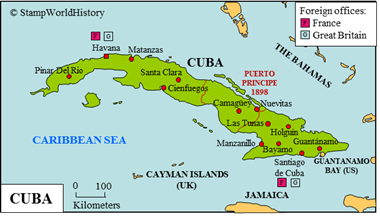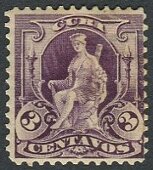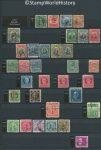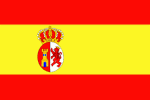
Cuba
Spanish colony

Cuba
Republic
Quick reference
General issues: Spanish colony 1873-1898, United States military adminisration 1898-1902, Republic 1902-Present
Country name on general issues: Ultramar, Cuba
Special issues: Regional issues Puerto Principe 1898-1899
Currency: 1 Peso = 100 Cents = 1000 Milles 1873-1881, 1 Peseta = 100 Centimos 1881-1898, 1 Peso = 100 Cents 1898-1899, 1 Peso = 100 Centavos 1899-Present
Population: 1 600 000 in 1900, 11 270 000 in 2013
Political history Cuba
Colonization
Cuba is located in the Caribbean as one of the Greater Antilles. Prior to colonization Cuba was inhabited by Amerindian peoples of which the Taino, Guanajatabey and Ciboney were the largest groups. The first European to explore Cuba was Christopher Columbus in 1492. Cuba was claimed for Spain and first settled by the Spanish in 1511. Administered, initially, from neighboring Santo Domingo, Cuba becomes a separate Captaincy General in 1607, which it will be until 1898. The Spanish possessions in the current United States – Florida and Louisiana – were administered from Cuba until ceded by Spain to the United States in 1819.
The road to independence
When, in the early 19th century, large parts of the Spanish Empire in the Americas gained independence, Cuba remained loyal to Spain. The first major independence movement manifested itself in 1868, when independence was declared and a provisional government was established, that gained support, however, only in the eastern provinces Puerto Principe and Santiago de Cuba. The Ten Years’ War[1]Also known as the Great War that ensued ended in Spanish victory. A second attempt at gaining independence resulted in the Little War from 1879 to 1880, but gained little support. The string of events that, eventually, led to Cuban independence, started with the foundation of the Cuban Revolutionary Party in 1892, which initiated the Cuban War of Independence in 1895. The war escalated into the Spanish-American War, when the United States intervened in 1898. The Spanish-American War – fought not only in the Caribbean but also in the Pacific – ended in a United States victory. Through the 1898 Treaty of Paris, Spain was forced to cede most of its possessions in the Caribbean and the Pacific to the United States – Cuba, through the treaty, was to become independent. The United States, subsequently, established a military administration on Cuba – effective in 1899. Cuba, eventually, gained independence as the republic of Cuba in 1902. Until 1934, Cuba was a de facto protectorate as the United States retained the right to supervise Cuban politics and, if need be, intervene. The Isles of Pines[2]The current Isla de la Juventud. remained under United States administration until ceded to Cuba in 1925. Guantanamo Bay was leased to the US in perpetuity and is a United States military base until today.
The Republic of Cuba

Fidel Castro and Soviet leader Nikita Khrushchev during a 1963 official visit to Moscow. Fidel Castro aligned Cuba closely with the Soviet Union.
The first decades of the independent republic of Cuba were politically unstable, resulting in United States interventions in 1906, 1912 and 1917. In subsequent years, Cuba would know periods of both democratic rule and military dictatorship. From the 1930’s until the 1950’s, Cuban politics were dominated by Fulgencio Batista. Batista implemented progressive reforms in the 1940’s, but established a military dictatorship in 1952 to retain his power. Opposition against Batista gained momentum in the 1950’s and culminated in the Cuban Revolution. The revolutionaries first engaged the Batista regime in 1953 and, led by Fidel Castro, eventually ousted Batista in 1959.
Communist Cuba
In the first years after the Revolution, Castro consolidated his power. Opposition, that engaged in an armed rebellion, was crushed. The Bay of Pigs Invasion, an invasion by Cuban refugees supported by the United States, was thwarted. The revolutionary groups, that had brought about the Cuban Revolution, formed the Cuban Communist Party in 1965 with Castro as First Secretary. The central role of the Communist Party in governing Cuba was embedded in the constitution in 1976.
In international politics, Cuba aligned with the Soviet Union. The United States severed diplomatic relations with Cuba in 1961. An attempt to establish a base for nuclear missiles, in 1962, brought the world close to nuclear war – the Cuban Missile Crisis. During the 1960’s and 1970’s, Cuba would be involved in a range of conflicts – supporting communist movements – in Central and South America and in Africa.
The dissolution of the Soviet Union brought major changes for Cuba, including economic liberalization and the need to improve foreign relations with other than communist countries. Fidel Castro was succeeded by his brother Raúl Castro – effective in 2006, officially in 2008. Raúl Castro continued – and probably intensified – the policy of liberalization that had been initiated in the 1990’s. A policy that led to reestablishment of diplomatic relations with the United States in 2015.
Economics and demographics
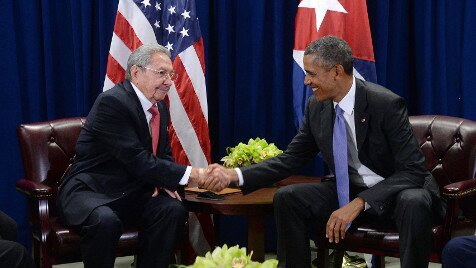
Raúl Castro and United States President Barack Obama during the 2016 visit of Obama to Cuba. Raúl Castro reestablished diplomatic relations with the United States.
In the colonial period, the Spanish developed a small scale, diversified agriculture. Large scale plantations were established only in the late 18th and early 19th centuries. Sugar cane would be the most important crop well into the 20th century. After independence, the economy diversified and Cuba became one of the most developed countries in the Americas. After the Cuban Revolution, Castro nationalized large sectors of the economy. As many Cuban based companies were United States owned, this strained relations with the United States. In 1961, the United States imposed the first sanctions. In 1962, the United States imposed a full trade embargo on Cuba. The economy came to be fully controlled by the government, which brought the economy in a downward turn. Cuba came to be heavily dependent on trade with and subsidies from the Soviet Union and its allies. The dissolution of the Soviet Union – and, thus, the loss of trade and subsidies – brought Cuba into a severe recession in the 1990’s. Economic reforms have resulted in partial recovery of the economy in the 2000’s. Currently, Cuba is considered a developed economy, ranking 135 out of 230 countries in terms of per capita GDP. Readily accessible social institutions, such as education and health care, however, qualify Cuba as a high human development country on the United Nations Human Development Index, ranking 67 out of 188 countries.
The composition of the population varies depending on resources used. The World Factbook quotes 64% of the population to be white, 27% mestizo and 9% black.
Postal history Cuba
The first stamps issued for use in Cuba were the issues for the Spanish West Indies – stamps issued for use in both Cuba and Puerto Rico – in 1855. These were superseded by issues specifically for Cuba in 1873. Until 1877, the issues for Cuba are inscribed ‘Ultramar'[3]‘Overseas’ probably because, until 1879, the issues were also used in Fernando Poo, a Spanish overseas possession in Africa. The stamps issued for Cuba during the colonial period are of designs common for the Spanish colonies.
Foreign offices operated on Cuba until 1877 – these handled foreign mail until Cuba joined the UPU in 1877. France operated an office in Santiago de Cuba from 1862 and in Havana from 1865. The British operated an office in Santiago de Cuba from 1858 and in Havana from 1867.
Under United States occupation, the first stamps were issued by the postmaster of the Puerto Principe province – overprints on Spanish stamps in 1898-1899 and on United States stamps in 1899. The United States military administration issued definitives in 1899. In 1902, the republic of Cuba issued its first stamps. Independent Cuba issued stamps mainly with themes of national interest until the 1960’s. From the 1960’s, the issues are a blend of themes of national interest and themes aimed at the thematic collectors market.
Album pages
← Previous page: Costa RicaNext page: Curacao →

